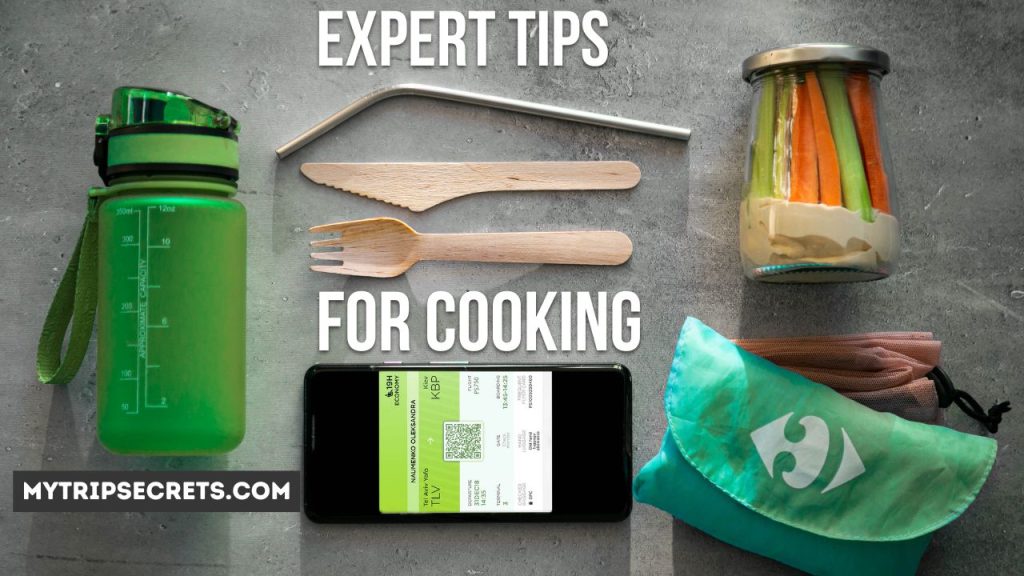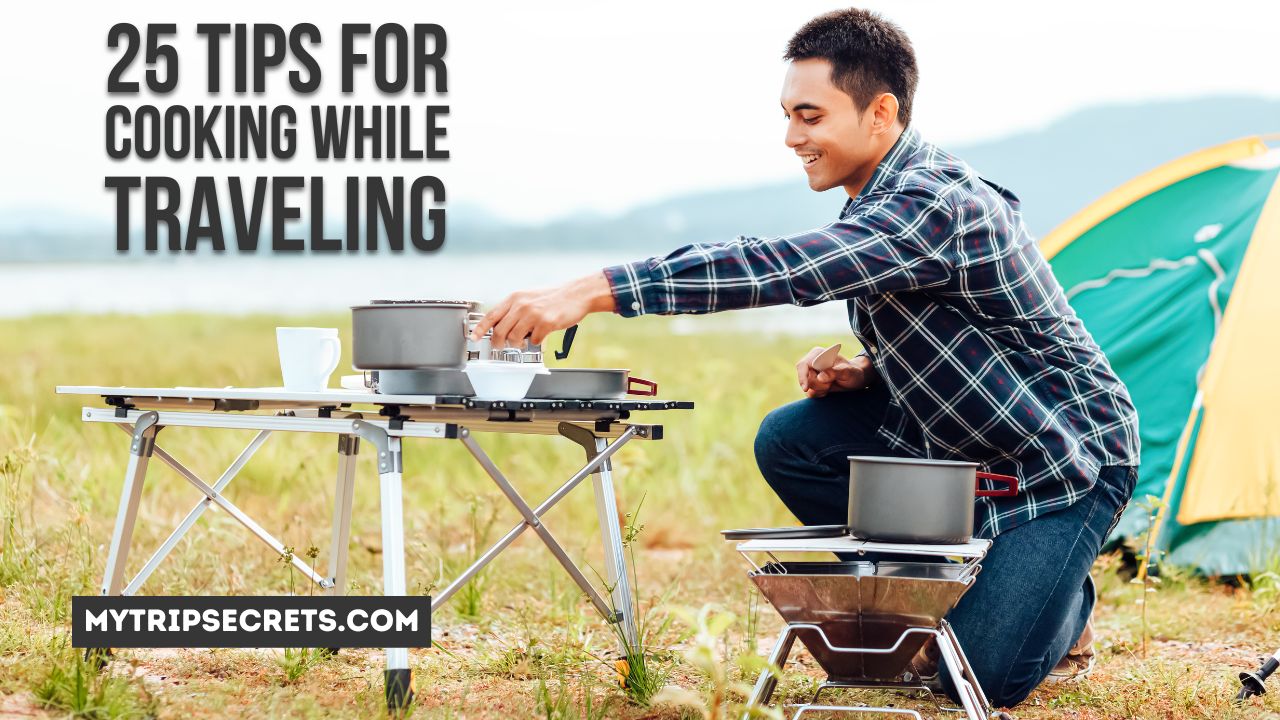Whether road tripping or backpacking abroad, eating economical yet exciting meals involves some travel cooking creativity. Whipping up flavorful dishes with limited ingredients and equipment while navigating unknown kitchens poses fun challenges though! This guide reveals 25 prime tips and tricks for cooking edible, enjoyable meals everywhere your wanderlust takes you.
Contents
- 1 Why Travel Cooking Matters
- 2 25 Best Tips for Cooking While Traveling
- 2.1 1. Select Multi-Purpose Electric Gear
- 2.2 2. Choose No-Cook Food Staples
- 2.3 3. Improvise “Kitchens” Anywhere
- 2.4 4. Research Local Ingredients
- 2.5 5. Buy Multi-Purpose Foods
- 2.6 6. Choose No-Cook Sauces
- 2.7 7. Cook Once, Eat Twice
- 2.8 8. Embrace One-Pot Wonders
- 2.9 9. Make the Most of Hotel Room Coffee
- 2.10 10. Seek Street Food Inspiration
- 2.11 11. Pack Essential Spices
- 2.12 12. Splurge On Oils
- 2.13 13. Dine Light During Day
- 2.14 14. Swap Appliances Creatively
- 2.15 15. Cook Once, Store For Later
- 2.16 16. Scout Local Markets
- 2.17 17. Research Regional Specialties
- 2.18 18. Seek Heat Sources
- 2.19 19. Embrace Tinfoil Packet Meals
- 2.20 20. Buy Rotisserie Chicken
- 2.21 21. Cook “Dangerous” Food First
- 2.22 22. DIY Quick-Cooking Grains
- 2.23 23. Purchase Precooked Proteins
- 2.24 24. Make the Most of Leftovers
- 2.25 25. Pack a Spice Kit
- 3 Packing the Right Supplies
- 4 Choosing the Right Accommodations
- 5 Grocery Shopping On Location
- 6 Creative Kitchen Solutions
- 7 Economical Eating
- 8 Food Safety Precautions
- 9 Easy Clean Up
- 10 Nutritious Options
- 11 Regional Cuisine
- 11.1 Frequently Asked Questions (FAQs)
- 11.2 Help! My hotel room lacks a kitchen. How do I cook full meals?
- 11.3 What are your top 3 portable cooker recommendations for road trips?
- 11.4 Where can I cook if my hotel room does not have a kitchen?
- 11.5 What food items can I take on flights for meals?
- 11.6 How should I adjust my cooking approach when traveling overseas?
- 11.7 I’m backpacking internationally for 6 months. How should I resupply food?
- 11.8 Help! My hotel threatened huge cleaning fines for cooking smells and grease stains left on room surfaces. What do I do?
- 11.9 What are the best foods to pack that require minimal actual cooking while road tripping?
- 12 Key Takeaways on Travel Cooking
Why Travel Cooking Matters
Dining out three times a day racks up massive vacation bills quickly. Preparing your own food saves substantially for extending trips and fun spending elsewhere. But simply not starving means strategically cooking with scarce resources. Here’s why travel cooking mastery is so useful:
- Saves money – Make lots of meals using limited ingredients purchased locally.
- Promotes healthy eating – Control nutrition and ingredients better than restaurants.
- Avoids risky foods – Prevent illness from improperly stored buffet items.
- Tailor to dietary needs – Cater flavors and restrictions yourself.
- Try local specialties – Cook regionally seasonal produce and flavors.
Research shows DIY cooking on extended vacations saves an average of 55% over strictly dining out. That buys a lot of activities and souvenirs! Now let’s get cooking…
25 Best Tips for Cooking While Traveling
1. Select Multi-Purpose Electric Gear
Items pulling double or triple duty maximize valuable pack space for travel cooking. Look for tools like grill pans that transition to skillets or kettles converting to serving dishes.
2. Choose No-Cook Food Staples
Stock non-perishable ready-to-eat snacks like protein bars, nuts, beef jerky, and dried fruit requiring zero prep for quick calories when lacking cooking time or resources.
3. Improvise “Kitchens” Anywhere
Random picnic tables, hotel bathroom sinks, ironing boards, engine blocks, campfires, irons, and coffee makers can all become impromptu cooking surfaces in a pinch. Think creatively!
4. Research Local Ingredients
Scope out regional vegetables, herbs, proteins, and oil varieties available at proximate grocers to inspire flavorful culinary creations unique to wherever you are.
5. Buy Multi-Purpose Foods
Ingredients wearing many hats maximize possibilities from minimal items. Bags do double duty as marinades and cooked sauces. Hard cheeses grate, cube, or melt into numerous dishes.
6. Choose No-Cook Sauces
Skip cooking by incorporating fresh salsas, chimichurri sauce, guacamole, pesto, tapenades, and dressings adding huge flavors instantly to proteins.
7. Cook Once, Eat Twice
Planning sequential meals using same ingredients saves hugely over time. Example: Roast chicken transitions into tacos, then soup.
8. Embrace One-Pot Wonders
Cooking full meals requiring only a single pot/pan allows preparing elaborate eats with minimal gear while saving cleanup time and water.
9. Make the Most of Hotel Room Coffee
Use in-room java makers for boiling water quickly to cook instant rice, make gravy, rehydrate backpack meal pouches, or crank out pot noodles in a jiff.
10. Seek Street Food Inspiration
Taking cues from sidewalk vendor cooking methods often provides clever hacks forMake the Most of Hotel Room Coffee replicating local specialties yourself using limited tools.
11. Pack Essential Spices
A tiny kit of salt, pepper, chili flakes, herbs de Provence, cumin, and soy sauce transforms boring staples into flavor powerhouses and enables improvising multiple ethnic recipes.
12. Splurge On Oils
Quality olive oil, sesame oil, truffle oil and the like transport easily and make even basic Hotel Room Rice and beans gourmet.
13. Dine Light During Day
Conserve stove fuel by focusing cooking efforts at night when easiest to cuddle up with comforting meals. Quick snacks and shelf-stable foods fill daytime gaps just fine.
14. Swap Appliances Creatively
Baffle irons pressed on towels cook meats or toasted sandwiches in a pinch. Rice cookers substitute for slow cookers. Contact grills replace skillets. Mix and match!
15. Cook Once, Store For Later
Prepare huge batches of hardy items like beans, soups stews and grains to stash precooked portions in portable coolers, then reheat single servings when needed later using minimal effort.
16. Scout Local Markets
Checking out food items popular across butcher stalls and produce carts provides clues what cooks well locally and inspires spicing ideas.
17. Research Regional Specialties
Read up on national dishes of wherever you are, then DIY them roadside using native ingredients and simplified homestyle shortcuts.
18. Seek Heat Sources
Scope parks and rest stops for public grills to quickly fire up kebabs and veggies. Beach driftwood burns for fish fries. Sunny car dashboards oven-bake casseroles.
19. Embrace Tinfoil Packet Meals
Assembling ingredients bundled in foil to toss straight on grills or in fire pits means no pans to clean – just unwrap and eat!
20. Buy Rotisserie Chicken
Shredded Rotisserie chicken strips up to top pastas, fold into quesadillas or nachos, stuff burritos, blend into pot pies and make amazing errythang!
21. Cook “Dangerous” Food First
Chow down perishables like eggs, fish and meat ASAP after procuring, then dine on longer-lasting vegetables and starches subsequently.
22. DIY Quick-Cooking Grains
Skip boiling big pots of rice or quinoa by sprouting or crushing grains first for lightning fast stovetop meals with less fuel.
23. Purchase Precooked Proteins
Rotisserie poultry, smoked fish, cured meats, boiled eggs, and other grab-and-go proteins minimize cooking efforts.
24. Make the Most of Leftovers
Transform straggling bits of anything into DIY fried rice. Blend veggies into brothy soups. Last chicken chunks star in next day’s tacos or sandwiches.
25. Pack a Spice Kit
A tiny tin containing salt, pepper, chili flakes, herbs de Provence, cumin, and soy sauce transforms boring basics into flavor powerhouses and enables improvising multiple ethnic recipes.
Packing the Right Supplies

Bringing the proper gear and ingredients can make all the difference when it comes to whipping up meals away from home.
Cooking Tools
Packing lightweight and versatile cooking tools helps minimize luggage while still allowing you to cook a variety of dishes.
- Pack a good knife, cutting board, peeler, can opener, and grater – these basic tools give you prep power.
- Bring a small pot with a lid, skillet, spatula, and cooking spoon for stove top cooking.
- Pack a portable stove, fuel canister, and mess kit for places without full kitchens.
Food Staples
Having key ingredient staples on hand makes pulling together a meal much easier.
- Pack oils, spices, sauces, and other flavor boosters like garlic, onions, lemons.
- Bring shelf-stable proteins like canned tuna, beans, nut butters.
- Pack hearty grains like rice, quinoa, pasta, oats.
- Take sturdy produce like potatoes, carrots, apples.
- Bring extending ingredients like broths, tomato sauce, milk powder.
Choosing the Right Accommodations
Opting for lodging with kitchenette access expands your ability to prepare meals on the road.
Hotels
- Seek out hotel rooms with kitchenettes or ask for a mini fridge.
- Extended stay hotels tend to have better equipped kitchens.
- Even basic rooms often have a coffee maker, microwave, and dishes you can use.
Vacation Rentals
- Rent an apartment, condo, cabin, etc. for full kitchen access.
- The shared kitchens in hostels also allow for cooking.
- For camping, pack camping stoves, grills, and cooking equipment.
Planning Your Meals
Take some time to plan out recipes before your trip to make cooking go more smoothly.
- Choose simple recipes with few ingredients that pack and travel well.
- Focus on one-pot meals like pasta, soups, stir fries, and casseroles.
- Prepare ingredients ahead of time by washing, chopping, measuring at home.
- Account for appliance availability and pack foods that work with what you’ll have access to.
- Research options for buying groceries at your destination.
Grocery Shopping On Location
Seeking out local supermarkets helps you source fresh, affordable ingredients during your travels.
- Ask your hotel or rental host for nearby grocery recommendations.
- Search online delivery services for easy groceries to your temporary home.
- Visit local markets and farms for a truly authentic and seasonal culinary experience.
- Buy small amounts of perishables so nothing gets wasted.
- Stock up on any specialty ingredients used in regional dishes you want to cook.
Creative Kitchen Solutions
With some innovative thinking, you can whip up tasty meals nearly anywhere using limited resources.
- Make single burner meals or use a crockpot for spaces with no stove.
- Grill or panini press sandwiches in rooms with no kitchen.
- Use coffee makers to cook hot cereal, stew, poached fish.
- Microwave scrambled eggs, baked potatoes, oatmeal.
- Wash dishes and produce in bathroom sinks.
- Spread out ingredients and prep area on beds or furniture.
- Use camping mess kits and portable stoves outdoors if needed.
- Improvise tools from bottles, cups, irons if lacking kitchenware.
Economical Eating
Preparing meals yourself generally costs a fraction of eating out while traveling. Here are some tips to further keep costs low:
- Stick to inexpensive staple ingredients like rice, beans, eggs, oats, potatoes.
- Look for deals on meat and produce that may be nearing expiration dates.
- Buy ingredients to make multiple meals to maximize what you purchase.
- Split bulk packages of items with traveling companions.
- Carry shelf-stable snacks to avoid pricey convenience store purchases.
Food Safety Precautions
While home kitchens can harbor bacteria, unfamiliar environments on the road present even more potential hazards. Take these steps to avoid foodborne illness:
- Wash hands thoroughly before cooking.
- Rinse fruits and vegetables, especially if eaten raw.
- Cook protein foods like poultry, eggs, beef to safe internal temperatures.
- Refrigerate perishable items right away.
- Use a food thermometer to verify temperatures.
- When dining out, opt for thoroughly cooked dishes.
- Avoid raw shellfish and unpasteurized items.
- When in doubt, remember “Boil it, cook it, peel it, or forget it.”
Easy Clean Up
Dealing with dirty dishes in cramped temporary housing can be a hassle. Implement these strategies for quick and convenient clean up:
- Line cooking surfaces with foil or wax paper for fast removal.
- Use paper plates and disposable utensils when possible.
- Purchase prepared/cooked ingredients to avoid extra dishes.
- Let plates and pans soak in sink instead of full sink washing.
- Wash as you go instead of leaving a towering pile for later.
- Travel with dishwashing tubs, soap, dishcloths, and drying rack.
- Make use of any dishwashers at rented spaces.
Nutritious Options
While traveling often involves indulging, preparing home cooked meals allows you to work nutritious ingredients into your diet.
- Pack wholesome snacks like fresh fruits, mixed nuts, protein bars.
- Include vegetables in every meal – slice into eggs, sauce, grains, etc.
- Focus meals around healthy bases like salads, brown rice, quinoa.
- Load up sandwiches and pasta with veggie fixings.
- Stay hydrated with water; avoid sugary drinks.
- Balance indulgences from eating out with nutritious hotel meals.
- Get moving and burn extra calories sightseeing on foot during your trip!
Regional Cuisine
One of the best parts of travel is experiencing new flavors! With access to a kitchen, you can try cooking authentic dishes from the region you are visiting.
- Ask locals for recommendations on staple ingredients and popular home cooked meals.
- Purchase cookbooks about the cuisine you want to try.
- Take a cooking class focused on regional speciality dishes.
- Shop at local markets and experiment with unique produce and spices.
- Browse food blogs, videos about making iconic area meals.
- Search Airbnb cooking experiences for a hands-on lesson from home cooks.
- Use local recipes as inspiration for travel inspired home cooking back from your trip!
Frequently Asked Questions (FAQs)
Still have pressing travel cooking questions? Here are some helpful answers:
Help! My hotel room lacks a kitchen. How do I cook full meals?
Coffee makers boil water for instant rices or pastas. Irons pressed on towels cook grilled sandwiches. Bathroom hair dryers bake small casseroles! Get creative blending appliance functions.
What are your top 3 portable cooker recommendations for road trips?
Single stove burners, mini slow cookers with locking lids that avoid spills, and plug-in contact sandwich grill gadgets rank among the best for easy cleanup and packability.
Where can I cook if my hotel room does not have a kitchen?
If your hotel room does not have kitchen facilities, look for these alternative cooking options: Use a crockpot, microwave, coffee maker hot water for basic heating tasks. Request a room with a mini fridge to store perishables. Ask about use of hotel lounge kitchen areas meant for events. See if your hotel has partnerships with nearby residences to allow meal prep access. Rent aunit with kitchen access via platforms like Vrbo, Airbnb, etc. even for a few nights.
What food items can I take on flights for meals?
Some easy portable food items you can pack to fuel flights include: Sandwiches and wraps with sturdy produce fillings.Hearty snacks like protein bars, trail mix, cut fruit, vegetables. Yogurt, string cheese, nut butter packets.Oatmeal packets you can cook with hot water from flight attendants. Dehydrated camp meals only requiring hot water. Canned tuna, chicken, or salmon and crackers. Hummus and pretzels or pita crisps. Peanut butter and apple slices. Jerky, popcorn, roasted chickpeas for salty crunchy cravings.
How should I adjust my cooking approach when traveling overseas?
Tips for cooking in foreign countries include: Research availability of familiar ingredients and suitable substitutions.Bring small amounts of key staples until you locate them. Prepare for different voltage appliances and types of cookware. Understand food handling standards may vary from home guidelines. Clarify washing produce protocols with locals. Check that tap water is potable, have a filtration system if not. Follow cultural norms like no beef products in India. Learn basics phrases related to ingredients, kitchen tools, dining out. Connect with expats who can advise on food culture there.
I’m backpacking internationally for 6 months. How should I resupply food?
Seek out large city grocery stores each 1-2 weeks to stock up on shelf-stable local staples like rice, grains, dried beans, sauces, jerky and nut butters. Supplement with fresh produce purchased every 2-4 days.
Help! My hotel threatened huge cleaning fines for cooking smells and grease stains left on room surfaces. What do I do?
Lay down towels anywhere you prep/cook to preserve surfaces. Plug-in devices like contact grills avoid stovetop splatter issues. Open windows immediately plus use bathroom fans to vent aromas rapidly after cooking.
What are the best foods to pack that require minimal actual cooking while road tripping?
Precooked quinoa or rice, canned tuna/chicken and veggies, nut butters, hearty raw veggies/fruits, protein-rich jerky, instant pastas and pre-made sauces require minimal prep for nutritious meals.
Key Takeaways on Travel Cooking
I hope these creative tips inspire some drool-worthy dishes prepared ingeniously wherever you wander using minimal equipment and ingredients. Remember these core advice nuggets:
- Scout out what interesting seasonal ingredients local grocers stock to inspire improvised regional recipes.
- Cook perishable proteins first while fresh, saving hardy veggies and starches for later.
- Prepare big batches of base items like rice or chicken to reuse across multiple quick subsequent meals.
- Think “one-pot meals” maximizing ingredients for minimal cleanup washing limited cooking tools.
- Splurge on quality fats and spice blends empowering basic staple transformations into amazing eats.
Apply just a few of these crafty philosophies and eating well on the road has never been simpler or tastier! Satisfy wanderlust appetites creatively.
More Helpful Article That Might Help You:
How to Get Clients as a Travel Agent
When To Start Packing for International Trip

